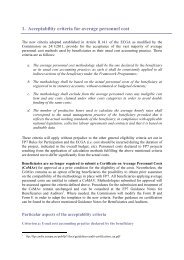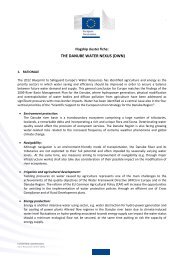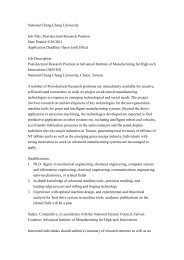Guide to Research and Innovation Strategies for Smart Specialisation
Guide to Research and Innovation Strategies for Smart Specialisation
Guide to Research and Innovation Strategies for Smart Specialisation
Create successful ePaper yourself
Turn your PDF publications into a flip-book with our unique Google optimized e-Paper software.
<strong>Innovation</strong> friendly business environments <strong>for</strong> SMEs<br />
Why should an innovation-friendly business environment be part of smart<br />
specialisation?<br />
SMEs are at the centre of the creation of jobs <strong>and</strong> growth at regional level. Furthermore,<br />
SMEs are key players in introducing new products/services in<strong>to</strong> the market place <strong>and</strong> offering<br />
innovative solutions <strong>to</strong> the gr<strong>and</strong> challenges. Entrepreneurship is necessary <strong>to</strong> make sure that<br />
innovation ideas are turned in<strong>to</strong> sustained growth <strong>and</strong> quality jobs.<br />
There<strong>for</strong>e, it is important <strong>to</strong> provide at regional level the right mix of financial <strong>and</strong> non<br />
financial supports <strong>to</strong> assist entrepreneurs <strong>to</strong> create new firms <strong>and</strong> existing enterprises <strong>to</strong><br />
innovate <strong>and</strong> develop. The support should aim <strong>to</strong> increase the innovation capacity of SMEs<br />
enabling them <strong>to</strong> develop, <strong>to</strong> access <strong>and</strong> <strong>to</strong> absorb new knowledge <strong>and</strong> thereby <strong>to</strong> grow <strong>and</strong> <strong>to</strong><br />
compete on increasingly global markets.<br />
Regional policy makers also have <strong>to</strong> underst<strong>and</strong> the different <strong>for</strong>ms of innovation such as nontechnology<br />
services, cross-sec<strong>to</strong>r technology integration, system <strong>and</strong> business model<br />
innovation, which are <strong>to</strong>day as important as the technology breakthrough innovation <strong>for</strong><br />
SMEs. It is relevant <strong>for</strong> the regional authorities <strong>to</strong> adapt their offer of support services <strong>to</strong> the<br />
dem<strong>and</strong> of the different types of enterprises: manufacturing, service oriented, high-tech or<br />
social ones. In this context, analysis <strong>and</strong> benchmarking of regional policies can be an<br />
important starting point <strong>to</strong>wards the development of regional strategies44.<br />
SMEs, <strong>and</strong> especially micro-enterprises, are heavily dependent on their regional environment<br />
where proximity plays a key role <strong>for</strong> innovation, in particular regarding the spread <strong>and</strong><br />
absorption of tacit knowledge. SMEs need policy support in tapping in<strong>to</strong> the necessary<br />
outside resources, principally access <strong>to</strong> knowledge, in the <strong>for</strong>m of advice through innovation<br />
support services <strong>and</strong> tailored counselling, technology or qualified human capital, <strong>to</strong> face up <strong>to</strong><br />
the new <strong>for</strong>ms of competition that are developing in the global economy. SMEs are thus at the<br />
core of Cohesion Policy.<br />
For the period 2007-2013, the Community Strategic <strong>Guide</strong>lines on Cohesion emphasize the<br />
key role of SMEs, notably when it comes <strong>to</strong> increasing <strong>and</strong> improving their investment in<br />
R&D, facilitating innovation <strong>and</strong> promoting entrepreneurship. Cohesion Policy in fact<br />
provides the largest financial Community support <strong>to</strong> SMEs, including through financial<br />
engineering instruments such as JEREMIE45. For the period 2014-2020, the Commission has<br />
proposed an even stronger focus on enhancing the competitiveness of SMEs in the context of<br />
Cohesion Policy.<br />
Moreover, the Cohesion Policy support often provides the initial plat<strong>for</strong>m <strong>for</strong> an increased<br />
number of SMEs <strong>to</strong> access the FP7 or the CIP, <strong>and</strong> will indeed continue <strong>to</strong> do so <strong>for</strong> the<br />
<strong>for</strong>thcoming successors of these programmes.<br />
44 See <strong>for</strong> example the Regional <strong>Innovation</strong> Moni<strong>to</strong>r initiative at: http://www.rim-europa.eu/<br />
45 http://www.eif.org/what_we_do/jeremie/index.htm<br />
70

















